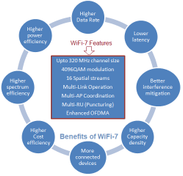LTE-U vs WiFi: Differences, Bands, and Coexistence
Advertisement
This article clarifies the differences between LTE-U (LTE Unlicensed) and WiFi. It also details the LTE-U bands used in various regions, including the USA, Europe, Japan, and China. LTE-U is designed to work alongside existing LTE and WiFi networks, not to replace them.
LTE-U operates in the 5 GHz frequency band, which is part of the unlicensed ISM (Industrial, Scientific, and Medical) band. A key aspect is that LTE-U transmissions are designed to avoid negatively impacting existing LTE or WiFi installations. LTE-U devices adhere to the LBT (Listen Before Talk) protocol before transmitting, ensuring fair coexistence.
The primary goal of LTE-U is to offload traffic from both existing LTE networks and busy WiFi hotspots. The specifications are defined in 3GPP Release-12.
LTE-U Frequency Bands
The following table outlines the LTE-U frequency bands and their corresponding EIRP (Effective Isotropic Radiated Power) levels in different countries.
| LTE-U Band | 5150 to 5250 MHz | 5250 to 5350 MHz | 5470 to 5725 MHz | 5725 to 5850 MHz |
|---|---|---|---|---|
| EIRP | 23dBm/36dBm | 23 dBm | 30dBm | 33dBm, 36 dBm |
| USA, Canada | ✓ | ✓ | ✓ | ✓ |
| Europe (EU) | ✓ | ✓ | ✓ | |
| Korea | ✓ | ✓ | ✓ | ✓ |
| Japan | ✓ | ✓ | ✓ | |
| China | ✓ | ✓ | ✓ | |
| Australia | ✓ | ✓ | ✓ | ✓ |
| INDIA | ✓ | ✓ | ✓ |
Both licensed LTE spectrum (700 MHz to 3.8 GHz) and the unlicensed 5 GHz spectrum can be combined using Carrier Aggregation to improve spectrum efficiency.
Here are some carrier aggregation modes supported in LTE-U:


LTE-U vs WiFi: Comparison and Coexistence
Here’s a comparison of LTE-U and WiFi and how they coexist:
-
LTE-U operates at a higher energy level than typical WiFi devices, which minimizes interference. WiFi Access Points (APs) typically use 24 dBm, while WiFi Stations (STAs) use around 18 dBm. LTE-U EIRP levels for different bands are mentioned in the table above.
-
LTE-U generally offers better spectrum efficiency compared to WiFi.
-
LTE-U has a coverage range approximately two times greater than WiFi.
-
LTE-U can provide a gain of up to three times compared to WiFi networks.
Advertisement
 RF
RF

